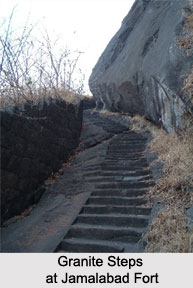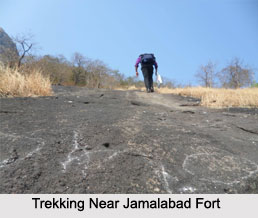 Jamalabad Fort`s walls are really welcoming, offering its massive rock cut steps like a sculpted carpet into its ruins. These very steps completely transform in the monsoon, becoming avenues through which fresh rainwater gurgles; it is beautiful to reckon with these seasonal streams. The Jamalabad Fort enjoys a popular reputation; however, it is in utter disarray. Cannons and other ruins lie around the peak, littered with plastic and other waste.
Jamalabad Fort`s walls are really welcoming, offering its massive rock cut steps like a sculpted carpet into its ruins. These very steps completely transform in the monsoon, becoming avenues through which fresh rainwater gurgles; it is beautiful to reckon with these seasonal streams. The Jamalabad Fort enjoys a popular reputation; however, it is in utter disarray. Cannons and other ruins lie around the peak, littered with plastic and other waste.
Location of Jamalabad Fort
Jamalabad Fort is an ancient hill fort that is located in Belthangady town in Belthangady taluk in the district of South Canara or Dakshina Kannada in Karnataka state. It is situated almost 65 km away from Mangalore. The fortress was built on the top of a granite hill at an altitude of 1700 feet above sea level. The structure was initially named as Narasimha Ghada. Jamalabad Fort is also known as Gadaikallu and Jamalagadda.
Architecture of Jamalabad Fort
There is a large water reservoir inside the premise of Jamalabad Fort. At the top of the structure, a cannon is installed which is in a dilapidated condition at present. There were several other building scattered throughout the vicinity of the fort at Jamalabad. The top of the fortress offers a panoramic view of the territory.
Architectural Importance of Jamalabad Fort
Jamalabad Fort was made by Tipu Sultan on a ruined mud fort constructed by earlier rulers. This fort was built with large scale help by French engineers who worked in the Tipu"s forces. This fort is built on a plateau that spreads nearly 4 to 5km on top of the hill. This fort was a strategic important point for Tipu"s army station during the war with British forces and local regional kingdoms.
This fort is cemented with high walls to defend heavy artillery from any sides. At vantage points, cannons were installed. The few rooms inside the fort were well protected from eternal threats and ventilated. The presently ruined rooms indicated space for lodging prisoners of war and slaves. The doors at the entry point of the fort are strongly built.
Historical Importance of Jamalabad Fort
The fort is named after Tipu Sultan"s beloved mother Jamalabee. On the eastern side of the hill with approximately 1876 granite cut steps, this fort is only accessible through a narrow path. A smaller well-armed defense unit can block larger force from directly entering this hill.
 According to the historians, it is strongly believed that Christian Catholic priests of Mangalore who disobeyed to immediate conversion to Islam was captured and lodged in Jamalabad fort before they were shifted to Serirngapatanam Fort. During the fourth Mysore war, this particular fort was captured by the British force of the East Indian Company and Nizam of Hyderabad. In this war, Tipu Sultan allied with French east Indian Company.
According to the historians, it is strongly believed that Christian Catholic priests of Mangalore who disobeyed to immediate conversion to Islam was captured and lodged in Jamalabad fort before they were shifted to Serirngapatanam Fort. During the fourth Mysore war, this particular fort was captured by the British force of the East Indian Company and Nizam of Hyderabad. In this war, Tipu Sultan allied with French east Indian Company.
Trekking in Jamalabad Fort
Jamalabad is a trekking destination, with the climb up to the fort being classified as `medium difficulty level` and the top of the structure offering good views of the surrounding landscape and the Kudremukh range. At the base of the hill is a forest check post where visitors have to pay a nominal entry fee. Visitors should carry plenty of water since there is no potable fresh water available on top. The nearest town with any communication and medical facilities is Beltangady. Entry to the fort is open between 6 am and 6 pm and overnight stay at the fort is prohibited. This hillock fort has one room at the top.
Present Condition of Jamalabad Fort
Most of the building lies in ruined state presently. Some parts of the fort wall with parapets are still intact. Currently the site has been developed as a popular destination for tourists and trekkers. It is now preserved and maintained by the Government of India.
Jamalabad Fort`s walls are really welcoming, offering its massive rock cut steps like a sculpted carpet into its ruins. These very steps completely transform in the monsoon, becoming avenues through which fresh rainwater gurgles; it is beautiful to reckon with these seasonal streams.



















